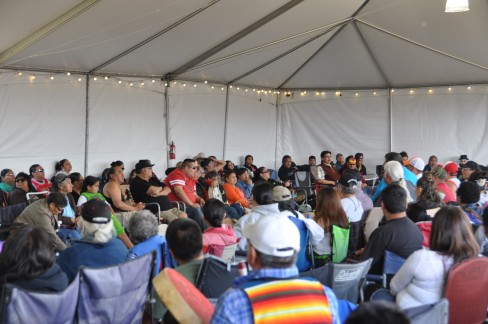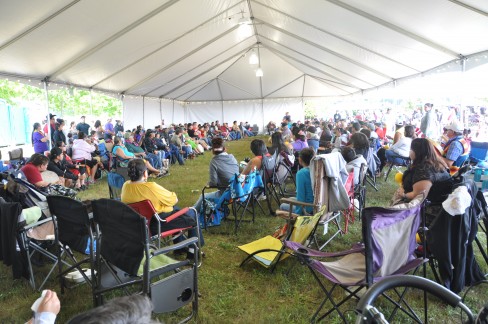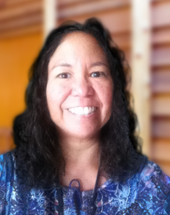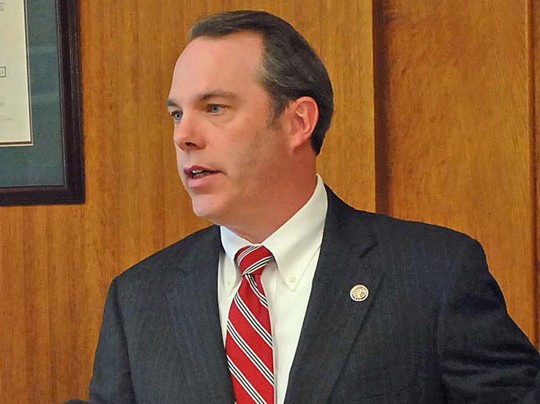Kenneth Shoji, San Manuel Band of Mission Indians
SAN BERNARDINO, Calif. – The ancient Native American language of Serrano, which was dying out as fewer and fewer native speakers of the language remained, has received a lifeline through the work of tribal people and academics.
The San Manuel Band of Mission Indians (Yuhaviatam Clan of Serrano) signed a historic agreement with Cal State San Bernardino on Friday, May 24, to have the Serrano language taught at the university by San Manuel linguists and a tribal elder through CSUSB’s world languages and literature department.
“Serrano is a language that came close to extinction,” said CSUSB President Tomás D. Morales. “Now through this agreement, the Serrano language will not only be perpetuated, but also its use will be expanded.”
Under the agreement, San Manuel’s Serrano Language Revitalization Project staff will teach the Serrano language course series – Serrano 101, 102 and 103 – at Cal State San Bernardino for the academic year 2013-2014, in collaboration with Ernest Siva of the Dorothy Ramon Learning Center. The course will cover the language, history and culture of the Serrano people. Along with CSUSB students, tribal citizens also will be able to take the Serrano course series through the university’s College of Extended Learning and receive college credit.
And, as part of the agreement, the tribe’s sponsorship in providing the instructors and curriculum for the course will be considered as a donation to the CSUSB Philanthropic Foundation.
“As we increasingly become an academic center that supports and encourages tribal heritage, we want to continue to build our relations with our native partners,” Morales said. “We want the tribal members of the San Manuel Band of Mission Indians to feel CSUSB is their home. We also want to extend that feeling of welcome to other tribes in our region.”
“It is my belief that our identity as Serrano people is rooted in our land, our culture and our language, each an aspect of the Serrano world connecting us to all that has passed before and all that is yet to come,” said San Manuel Chairperson Carla Rodriguez. “This course will allow Serrano Indian people and Cal State San Bernardino students an opportunity to bring new life to our ancient and sacred language.”
The Serrano Language Revitalization Program, a function of the San Manuel Education Department, conducts regular, ongoing research to develop and publish Serrano resources, including a dictionary and grammar book. This process includes weekly field work with Ernest Siva and is directed by San Manuel Tribal Members, including Education Committee Chairman Paakuma’ Tawinat, who helped lead the tribal effort to establish the Serrano language course series.
“By being involved in the community through our educational outreach, San Manuel has found opportunities and partners to bring new vitality to the Serrano language and culture. On the reservation, we have made great strides to take a traditionally only-spoken language and create a modern written language,” Tawinat said. “The Serrano language is a very important part of our lives, and along with our traditions, it defines who we are as people. It is a great honor to share our language with students, to see it grow and preserve the memory of our ancestors.”
Siva, who has also taught prior courses on culture and language at CSUSB, agreed. “I’m honored to be involved in making the language available to anyone who wants to learn it. It’s kind of like a dream,” he said. “Who’d ever think it would happen?”
Siva grew up on the Morongo Indian Reservation, where he learned the Serrano language and serves as tribal historian and cultural adviser for the Morongo Band of Mission Indians. Siva, who has been a strong proponent for the preservation of American Indian culture, founded and serves as president of the Dorothy Ramon Learning Center, which saves and shares all Southern California’s American Indian cultures, languages, history, music and other traditional arts.
Siva earned both a bachelor’s and master’s degree in music education and choral music from the University of Southern California and serves as a distinguished guest artist in Native American culture at Cal State San Bernardino. Siva also serves on the board of directors of the California Indian Storytelling Association, the board of trustees of Idyllwild Arts, and the board of the Riverside Arts Council. He also is a member of the CSUSB Philanthropic Board of Directors and recipient of an Honorary Doctorate of Fine Arts from the university in 2009.
Morales said the university’s courses on cultural resource management, museum studies, geography and archaeology will focus on maintaining Native American cultural identity and protecting tribal autonomy to further cement the university’s commitment to work with American Indian tribes in the region.
The agreement is another part of the university’s ongoing effort to preserve Native American records.
Over the past year, Thomas Long, an associate professor in the CSUSB history department and its coordinator of public history and internships, has had his students digitize and catalogue the Mission Indian Federation records at the National Archives.
Long’s students also have been digitizing and cataloguing the St. Boniface Indian School records at the San Bernardino Roman Catholic Diocese archives. The archiving project will run through the summer and fall quarter of 2013. At its conclusion, a full copy-set of the materials will be delivered to the San Manuel archives.
In addition, Long’s students have been completing their internship work at the Dorothy Ramon Learning Center, working on various projects aimed at the Serrano and Cahuilla culture preservation as well as other significant archival projects with tribal elder Ernest and his wife, June Siva.
Visit the Dorothy Ramon Learning Center website at
www.dorothyramon.org for more information, as well as the San Manuel Band of Serrano Mission Indians website at http://www.sanmanuel-nsn.gov/.
For more information on Cal State San Bernardino, contact the university’s Office of Public Affairs at (909) 537-5007 and visit news.csusb.edu.















